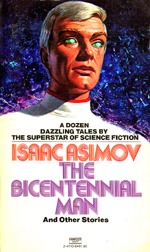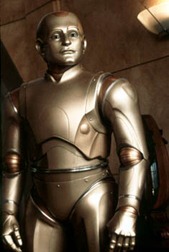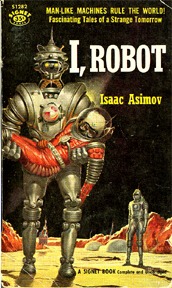

Back to Science Fiction/Fantasy Art


Read the story instead.
12/16/99
This year baseball's Dodgers and Orioles both proved that you could spend $75 million, collect a team of talented players with great track records, and still wind up as stinking losers. The Bicentennial Man proves the same about movies.
It should have been wonderful. Robin Williams, of course, needs no introduction. Director Chris Columbus had previously worked with Williams on Mrs. Doubtfire and had a hand in writing Goonies, Gremlins and Young Sherlock Holmes. And the film is from a novelette by Isaac Asimov, only the greatest science fiction writer of the 20th century. The story itself garnered both the Hugo and Nebula awards, science fiction's highest honors for the finest in writing.
I first read the story years ago, and like many of Asimov's, it sticks in the brain. The idea is that there is a robot who slowly becomes a human being over 200 years (hence the title, bicentennial man). The robot is purchased by the Martin family as a manservant, but begins to show undue amounts of "personality." His manufacturer, U. S. Robots and Mechanical Men, suspects a flaw in the construction of his positronic brain and wants him back for "study" (read: dismantling). The father of the family will have none of that, and the robot stays with the family for decades. While given a serial number beginning NDR (the robot's forgotten the numbers), he's renamed "Andrew" by the youngest daughter, Little Miss. Through the years Andrew becomes Little Miss's playmate, best friend and, in the most interesting parts of the story, an advocate for robot rights. In a powerful scene in the story, Andrew takes his first walk alone outside the family house - he wants to go the library. But he is stopped by two teenage bullies who demand that he stop and disassemble himself so they can steal him. Andrew must comply because robots have no rights. Ultimately, though, Andrew lives a long and full life, becoming the first robot to gain its freedom, the first to wear clothing, the first to change himself to become physically more human, and the first to finally demand full acceptance as a human being. That's the way the story goes - and it's the saddest and most poignant thing Asimov ever wrote.
The movie follows the overall plot of the story pretty closely, with some minor changes. The major additions, which are clunky, include an unnecessary love story and a second, female robot who dances to Aretha Franklin and has the personality of a Barbi doll.
I loved the story, but when I heard last year that Robin Williams was cast as Andrew, I had my doubts. Williams and Asimov, two great tastes that might blow chunks together. Or, in another metaphor, a rock-n-roll supergroup that collapses under the weight of conflicting personalities and agendas.
The Andrew of the story is the most serious of characters. He is well aware of the political and social ramifications of his struggles to become human; he changes history - not just the history of robotics, but the history of mankind. And his efforts comes at great personal cost, physical and emotional, to himself.
In some ways, it seemed like it would work on paper - Williams' movies have become more serious as of late, and he often appears in films with sad endings. He even starred in a film (bomb) called Being Human, which is the whole point of this movie.
But I was right, though. It doesn't work.
The movie veers wildly from the serious to the comic, and never feeling comfortable with itself. For instance, critical to an understanding of why characters do what they do is knowing Asimov's Three Laws of Robotics, which first appeared in print in 1941. Devising these laws was a major breakthrough - Robots had previously only been maniacal mechanical monsters. Asimov changed all that - robots became gentle, intelligent, if limited creatures, playmates, co-workers, even our peaceful guardians. Asimov's laws directly paved the way for cinema's first benign and beloved robot, Robby of Forbidden Planet (1956). Here are the laws of robotics:
1. A robot may not injure a human being or, through inaction, allow a human being to come to harm.
2. A robot must obey the orders given it by human beings except where such orders would conflict with the First Law.
3. A robot must protect its own existence as long as such protection does not conflict with the First or Second Laws.
(A Zeroeth Law about not harming humanity was later introduced.)
The conflicts in Asimov's story often revolved around contradictions and loopholes among the laws.
The movie could have presented these three important laws in title cards, read by Robin Williams, simple white lettering on a black background. Cost: 5 cents. No. Instead, the robot Andrew has lamps that spring from his head. The laws are projected in a wild, blaring calliope of light and sound, making them unintelligible and unreadable and completely frightening the family. This moment is, probably, intended to be funny, but it winds up being insulting. As if the director doesn't believe the audience is willing to simply read - READ! - three lines of text projected on a screen. The moviemakers seemed to have too much money (I read a report that the budget was actually $100 million), and needed to show it off.
This, I think, gets at the heart of where the movie went wrong. It was simply too expensive, and the money spent in the wrong places. First, I'm not sure how much Williams cost, but it must have been a small mint. Williams is a fine actor, of course, but as I discussed above, not suited for this movie. A better choice would have been an unknown, or even Sam Neill, who plays the father of the Martin clan. Seeing the various iterations of Robin's face - the robot version, the middle aged ("normal") version, the aged version, is unsettling. The point of the film is the robot becoming human, and the old age makeup isn't believable or transparent. Under all that latex, Robin becomes less human-looking at the end of the film. A better choice would have been to actually use an older actor. (A similar problem crops up with Embeth Davidtz, who also struggles to play multiple roles of varying ages.)
Money was also spent in the wrong place is the scenery (which should have been a no-brainer in this day of glitzy sci-fi). The moviemakers attempted to convey a passage of 200 years with establishing shot cityscapes. The cityscapes themselves are just as nice as Coruscant, with pretty buildings and flying buses, smoothly and expensively computer generated. The problem is that all the cityscapes look the same - there is no apparent change of architecture in 200 years. Asimov conveys sweeping change in a phrase or two, probably at a pay scale of 2 1/2 cents a word: "The Earth itself was becoming parklike" and "the Moon had become a world more Earthlike than Earth in every respect but its gravitational pull." The CG artists couldn't top that with the millions they spent.
Clothing styles don't change, either (and costumes are way cheap). Again, Asimov conveyed the passage of time in a few simple words - mentioning in passing the static charge used instead of a button fly to close trousers, or the "heavy makeup that fashion was dictating for both sexes" or a woman wearing "transparent clothing (obscuring what she wanted obscured only by their dazzle)." Clothing itself is an important element in the story, because Andrew becomes the first robot to ever wear clothes, and also maintains his individuality by resolutely wearing clothes which are out of step with the times. A simple thing, but the filmmakers dropped the ball.
Ultimately, the problems were too much money, too much comedy, too much Robin Williams. Not enough Asimov. Another chance at filming a great story, another lost opportunity. This is a sad movie, but that is the real sadness.
Scoring:
Style: 3.5/10
Substance: 6.5/10
Overall Coolness: 5/10
Additional random note: Asimov only wrote the story for an anthology to celebrate our nation's bicentennial in 1976. He and others had been asked to write a story - any story - for the book, provided it sprung from the phrase "the bicentennial man." The anthology eventually fell through, but the story remains. Asimov's collection The Bicentennial Man and Other Stories is, unfortunately, out of print, but I hope that the movie brings it back.

In any case, you should read this book, too.
Agree or disagree? Let me know.
From Greg Cannom
12/17/99
I'm Greg Cannom. I did the aging makeups. I find it interesting that you pointed
out that the makeup wasn't believable or translucent, and very latexy.
There was no latex used. These were overlapping silicone
makeups that we invented for this film, and were extremely translucent. This
process has never been done this way in a film before, and I think they worked
amazingly well.
And I'm the first to admit, when it doesn't work.
I still find the translucency remark interesting!
Greg Cannom
My reply to Greg Cannom:
Hi, Greg. I looked you up in the imdb,
and, uh, I feel like I've been called up to the Principal's office - or perhaps
God's office - and told to stand and make an account of what I've said.
Yikes. (And I didn't even think ANYBODY read my reviews.)
First, I feel like I should grovel a bit. I see you've
won, uh, two Academy Awards for makeup and been nominated for a few more (you
shoulda won for Titanic). I see you've done makeup for, well, two
decades and over 70 different TV shows and movies. Sure seems like you
know what you're doing. I was especially impressed with the stuff you did for Bram
Stoker's Dracula and Alien3 - but for different reasons. In Dracula,
a lot of characters looked bizarre and scary in a remarkable and original way;
in Alien3, everybody looked gray and pasty, liked they'd been constantly
rained on every day for ten years straight, and, of course, the aliens looked
scary as hell.
I'm sorry if I was perhaps a little short and flip with my brief
words about the makeup in Bicentennial Man.
However, now I get to the part where I feel like I'm bring coals
to Newcastle, or, in perhaps a better metaphor, telling God how to run His
universe.
About old age makeup... The weird thing is that the old
age makeup worked well for me in Titanic, but didn't as much in Bicentennial
Man. When I look at an old person's face, I see a couple different
types of wrinkles - surface wrinkles, like Saran wrap, and then deeper wrinkles,
like miniature San Andreas faults running across people's faces. In older
people's faces, I also see a lot of tiny spotting and just weird patches of
slightly different color. Little lines of slight blue or purple or other
cold colors where you can almost see veins, or age spots or little pinpricks of
pimple scars or nicks that didn't quite heal right - scar tissue always seems a
little whiter or redder than the surrounding tissue. I mentioned
translucency - I guess what I meant was seeing an almost transparent layer of
skin, but being able to make out some hidden scars or veins underneath - skin
like the NASA pictures of the ice flows of Europa. In that wonderful shot
in Titanic where we zoom in and computer blend between Kate Winslet and
Gloria Stewart, you see all that and more, and it's completely believable. The
thing that always bothered me about Mrs. Doubtfire (sorry) is that
Robin's makeup for her seemed too smooth and puffy and monochromatic. I
expect to see such monochromatism in a porcelain doll - and, for the record, it
bothers me sometimes to see monochromatism in non-aged people, too. I
think one of the reasons Monica Lewinsky is so stunning is because her face is
so remarkably even, clear, and white. But, in 40 years, she'll probably look
like hell like A lot of old people (e.g., look how spotty and red Ted Kennedy
looks these days). The same thing (monochromatism) bothered me when I saw many
of the Star Wars creatures - like the blue elephant in Return of the Jedi, who
was blue - and the same blue - all over. An alternative extreme is the
spots you see in some Star Trek characters like Dax in Deep Space Nine or
Neelix on Voyager, or Babylon 5's G'Kar. Despite questions
about his personality, I find Neelix fascinating to LOOK at - all mottled and
shaded and dappled and splotchy, like a real animal. I suppose with people
you can't have spots like a Trill, but there must be some MIDDLE GROUND between
spotting-a-go-go and Monica smoothness.
Now I've ranted for a while, but I neglected a point that you
made. I stand corrected that you didn't use latex (I read about latex in Starlog
in the 70's, but admittedly haven't kept up on my makeup technology).
Overlapping silicone layers, you say. Sounds very interesting - was the
idea to get some of the lower layers to pull in one direction while other layers
pulled in a different direction - like layered muscles with different attachment
points? I was wondering if you could tell me more about this, sounds
really neat. I just looked up on the Internet for some more pictures of Bicentennial
Man, and I found some pictures of Sam Neill and Embeth Davidtz as old
people, but not Robin Williams. (Perhaps the studio is trying to keep this
part of the movie a surprise.) Of the three (Neill, Davidtz, Williams), I
find Neill's makeup the most believable, though I'm not sure I could articulate
why (perhaps I because I really liked the randomness of the grayness shot
through his hair). I found the sagginess and shapes of the facial
appliances believable - with one exception. That exception is the
hollowness of the cheeks which many old people have. And I know in makeup
you are adding mass (layers), and perhaps adding mass in surrounding areas to
make the cheeks look hollower. I know you can't go around gouging out
tissue from Robin Williams' face. Is there some other way around this?
Maybe putting something inside the actors' faces between the cheek and gum that
kinda sucks the cheek in - or makes them stick to the teeth? Just an idea.
But other than the cheek thing, I thought the sags and wrinkles were believable
- the droopiness under Ms. Davidtz's jawline is especially subtle and nicely
shaped, and you convey a lot of weariness and exhaustion in her eye shapes.
It was just the monochromatism that bothered me.
Anyway, these are my general thoughts about makeup in movies and
Bicentennial Man in specific. Again, sorry I was so flip and short
about my comments about B'man. But also thanks for working on so
many movies, many of which had makeup moments that are burned into my
consciousness.
Frank
Back to Kitsch Tour U.S.A.
Back to Official Frank Wu Homepage